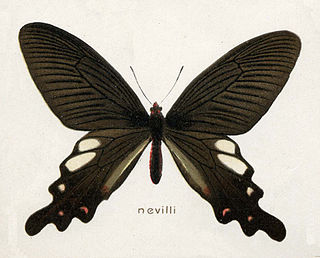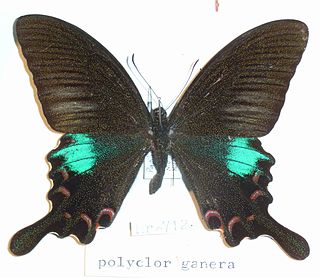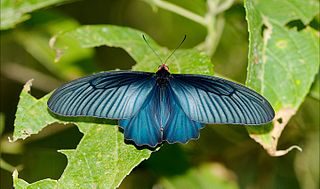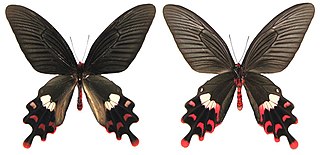
Bhutanitis lidderdalii, the Bhutan glory, is a species of swallowtail butterfly, which is found in Bhutan, parts of northeastern India and of Southeast Asia. A spectacular insect much sought after by collectors, the species epithet is after Dr R. Lidderdale, from whose collection the butterfly was first described by William Stephen Atkinson in 1873. Listed under CITES Appendix II, the status of the butterfly has been recorded as rare by some authorities but as being of least concern in 2019 by the Red Book of the IUCN.

Byasa dasarada, the great windmill, is a butterfly found in India that belongs to the windmills genus, Byasa, comprising tailed black swallowtail butterflies with white spots and red submarginal crescents.

Papilio alcmenor, the redbreast, is a species of swallowtail butterfly found in South Asia.

Papilio crino, the common banded peacock, is a species of swallowtail (Papilionidae) butterfly found in parts of the Indian subcontinent, including India, Nepal, Bhutan and Sri Lanka.

Byasa polyeuctes, the common windmill, is the most common member in India of the windmills genus (Byasa), comprising tailed black swallowtail butterflies with white spots and red submarginal crescents.

Byasa nevilli, the Nevill's windmill, is a butterfly found in India that belongs to the windmills genus (Byasa), comprising tailed black swallowtail butterflies with white spots and red submarginal crescents.

Pachliopta jophon, the Ceylon rose or Sri Lankan rose, is a butterfly found in Sri Lanka that belongs to the swallowtail family. It was earlier classified as a subspecies of Pachliopta hector, the crimson rose.

Papilio castor, the common raven, is a species of swallowtail butterfly found in Cambodia and South Asia.

Papilio krishna, the Krishna peacock, is a large swallowtail butterfly found in forests in China, Nepal, north east India, Myanmar and Vietnam.

Papilio polyctor, the common peacock or indian peacock or mahaonovaya indian butterfly with emerald- is a swallowtail butterfly found in the Indian subcontinent. It is found in the Himalayas and parts of India from the foothills to 7,000 feet (2,100 m) between March and October. It has distinct dry- and wet-season forms. The butterfly frequents Buddleia flowers. Its food plant is Zanthoxylum alatum of the family Rutaceae. Papilio polyctor has three subspecies, consisting of Papilio polyctor significans, Papilio polyctor stockleyi, and Papilio polyctor xiei.

Teinopalpus imperialis, the Kaisar-i-Hind, is a rare species of swallowtail butterfly found from Nepal and north east India to north Vietnam. The common name literally means "emperor of India". The Kaisar-i-Hind is much sought after by butterfly collectors for its beauty and rarity. The green iridescence of the wings has been found to be due to three-dimensional photonic structure of the scales and is the subject of much research.

Meandrusa sciron, the brown gorgon, is a species of swallowtail butterfly found in parts of South Asia and Southeast Asia. It belongs to the hooked swallowtails genus, Meandrusa, of the family Papilionidae. The brown gorgon is found in India from Sikkim to Assam and north Burma and is not considered to be threatened. Though not uncommon, it is protected under Indian law under the name gyas.

Losaria coon, the common clubtail, is a butterfly belonging to the swallowtail family, Papilionidae. The butterfly belongs to the clubtails, genus Losaria. It includes several subspecies and is found from the Nicobar Islands and Assam in India, east to Hainan in China, and south through Indochina, to Java and other islands of Indonesia and Bangladesh.

Papilio (Chilasa) agestor, the tawny mime, is a swallowtail butterfly, native to Indian subcontinent and widely found across Asia. The butterfly belongs to the mime subgenus, Chilasa, of the genus Papilio or the black-bodied swallowtails.

Byasa latreillei, the rose windmill, is a butterfly from the windmills genus (Byasa), found in various parts of Asia, comprising tailed black swallowtail butterflies with white spots and red submarginal crescents.

Atrophaneura aidoneus, the lesser batwing, is an Asian species of butterfly that belongs to the batwings group of Atrophaneura, comprising tailless black swallowtail butterflies.

Atrophaneura varuna, the common batwing, is a butterfly found in India and Southeast Asia that belongs to the swallowtail family, and more specifically, the batwings group of Atrophaneura, comprising tailless black swallowtail butterflies.

Byasa polla, the De Nicéville's windmill, is a butterfly found in India that belongs to the windmills genus (Byasa), comprising tailed black swallowtail butterflies with white spots and red submarginal crescents.

Byasa plutonius, the Chinese windmill, is a butterfly found in Asia that belongs to the windmills genus (Byasa), comprising tailed black swallowtail butterflies with white spots and red submarginal crescents.



















